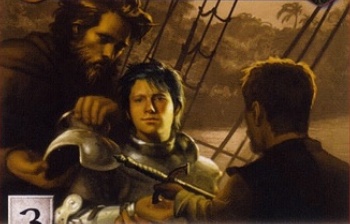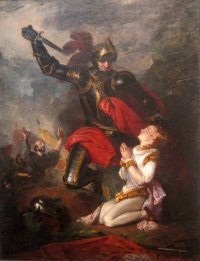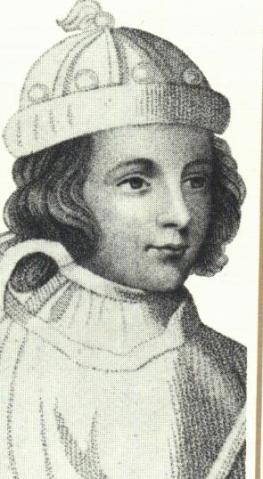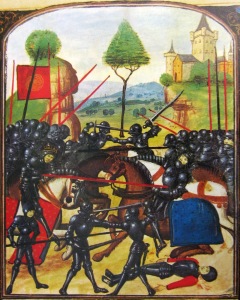
On the 30th of October 1485, the Tudor Dynasty officially began. Henry Tudor, the former Earl of Richmond, son of the first Earl of Richmond, Edmund Tudor and Lady Margaret Beaufort (now Stanley), was crowned King of England at Westminster Abbey. His coronation progress began on the 28th when he took possession of the tower. On the 29th where he processed to Westminster. Dressed for the occasion, he was followed by his prime courtiers, men who had fought with him at Bosworth and others who had recently sworn their loyalty to him.
“Heralds, sergeants-at-arms, trumpeters, esquires, the mayor, aldermen, and nobles, preceded the king dressed in their rich liveries, amongst them

Drawing from the royal chronicle and other observers, historian Dan Jones, describes how England’s new king displayed his power in one of the grandest events of the fifteenth century.
“Accounts of the coronation were drawn up by Sir Robert Willoughby, and they spoke of a flurry of activity among the goldsmith, cloth merchants, embroiders, silkwomen, tailors, laborers, boatmen and saddlers of London. Instruction went out for yards of velvet and silk in royal purple, crimson and black, which were then run up into beautiful jackets, hose, hats, robes, wall hangings, cushions and curtains. Henry’s henchmen were ordered hats plumed with ostrich feathers, boots made from fine Spanish leather and striking costumes of black and crimson” -Wars of the Roses: The End of the Plantagenets and Rise of the Tudors
Henry was a quarter Welsh -something that like his granddaughter, Mary I’s Spanish ancestry, has been used against him. But if we look at the royal bloodlines of other kings and queens, we find that all of them had different nationalities. There was no such thing as pure-English. Even Elizabeth of York and her siblings whose parents were both English were not pure-English. Elizabeth Woodville’s mother, Jacquetta of Luxembourg was French. Most of the English premier noblemen owed their fortunes to their Norman ancestors. They came to England with the Conqueror, William, Duke of Normandy, who (like Henry Tudor) challenged the English King for his crown and defeated him at battle.
And even the Anglo-Saxons were not native to England. Before them, there were the Celts and other tribes who they themselves
Yet, the concept is one that remains very popular and as centuries passed, and the geo-political situation of the British Isles continue to change, the pendulum swung in the other direction. Henry was an usurper, a foreigner and a rogue whereas Richard, an angelic King, was a just man who had been unfairly robbed of his divine right.

Jane Austen is a perfect example of this new geo-political landscape. Before she became a published author, Jane wrote during her teenage years that Henry was “as great a villain as ever lived” who “made a great fuss about getting the crown and having killed the king at the battle of Bosworth.” Jane went on to add that the only good thing that came out of Henry VII (and his dynasty for that matter) was his eldest daughter whose descendants united both crowns, and Henry VIII whose reign saw the creation of the Anglican Church. Jane had plenty of bad things to say about Henry VIII too but thought he wasn’t “quite so bad as his daughter Elizabeth.”
Fast forward to a few decades later to the Victorian era and you see an increase in popularity for Richard III. This is not surprising. England’s national identity was more important than ever. Xenophobia was in the air and with the English queen being half-German married to her cousin who was German, it became more important than build on that national identity. As a result, countless writers began to rely on secondary sources that distorted most first-hand accounts, painting a picture about the Tudors -namely Henry VII and his mother, Margaret Beaufort- that was far removed from reality.
As the pendulum continued to swing in Richard’s direction, the real Henry faded into obscurity. What Shakespeare, Vergil, and countless others had done to Richard during the Tudor regime, now these chroniclers were doing the same to them. It looked as if karma had its due but in truth, it was nothing more than reactionary writing.
At the time that Henry VII became King of England, the country was in chaos. Everyone was holding their breath, eager to see their new king walking down the streets of London, hoping -begging the almighty- that his reign would last and usher in an era of peace and economic prosperity.
Henry VII achieved the former during the last years of his reign, though the chronicles would have everyone believed that he put an end to the wars of the roses the minute he defeated Richard’s forces. The latter was also achieved but it came at a high price. By the time of Henry VII’s death, the crown’s coffers were full but his subjects’ adoration for him had become almost non-existent. Henry levied excessive taxes on the rich and poor alike, and while he survived every rebellion against him, people’s animosity for him continued. Henry’s attitude is largely owed to his reasonable paranoia. Living fourteen years of exile had taught him that he would never be safe unless he rooted out all his enemies.
Few people comprehended this; those that did had died except for his mother whom he continued to rely on for emotional support.
Margaret Beaufort was an indomitable woman, someone who had more experience at court than Henry did. But he quickly learned how to navigate that world thanks to his stay at the Breton and French courts during his exile.
When Henry VII returned to his royal quarters that October 29th, he prepared himself for the big day ahead of him on the morrow where all of his hardships and endeavors would finally pay off.
Besides his uncle Jasper Tudor, his stepfather, Sir Thomas Stanley and his brother, William Stanley, other men who had fought alongside him at Bosworth were also there.
The ceremony was performed by John Shirwood, Bishop of Durham, Robert Stillington, Bishop of Bath and Wells, Courtenay, Bishop of Exeter, and John Morton, Bishop of Ely. The archbishop of Canterbury, the head of the Catholic Church in England, did not play a prominent role but it still fell unto him to anoint the new king and place the crown upon his head.

Everything else also went according to protocol. After Henry had the holy oils placed on him and he was changed into parliamentary robes, the archbishop put the crown of St. Edward the Confessor on his head then turned to his ministry asking the crowd if they accepted their new monarch. Everyone chanted in unison “Yea, yea!”
Henry, Seventh of that name, never felt more jubilant. So did his mother, although her confessor John Fisher said that her tears were more from fear than of joy. Having lived through three kings, Margaret was afraid that her son would share the same fate.
If Henry was aware of this, he did not show it. Determined to enjoy his triumph, he returned to the Tower of London for the coronation banquet. His uncle Jasper took precedence over other nobles, riding ahead of them, a little far behind his nephew.
Once at the banquet, Henry and his honored guests enjoyed a variety of courses. After the first course, the king’s champion Sir Robert Dynmock came in, issuing the customary challenge, demanding who would challenge the King’s authority. There were more performances to be found that day, among them the iconic representation of the royal arms of England and France along with those of their new king emphasized his Welsh ancestry. But more prominent among them was the Tudor rose. Henry Tudor was a religious man, and as those that came before him, he chose a rose because of its religious significance. The red rose was a symbol of Christ’s passion, while the five petals corresponded to the five wounds Christ had suffered on the cross. Roses were ones of the most notable symbols on the Abbey, and on the courtier’s clothing.

The white rose had become representative of the House of York as the red became representative of their opponents, the House of Lancaster which Henry was meant to embody. Henry had sworn to marry the beautiful Elizabeth of York after he became king, but with so many Yorkist heirs still abounding, he hesitated to marry her straight away. Instead, their union was postponed until January of the following year.
Elizabeth was widely loved in the North as the eldest Princess of York. And her marriage to Henry symbolized the union of the two warring branches of the Plantagenet House from which they both descended: Lancaster & York which was embodied in the Tudor rose. Roses were very popular symbols during the middle ages. They symbolized the Virgin Mary, in the case of the red rose as Leanda de Lisle explains:
“The simple five-petal design of the heraldic rose was inspired by the wild dog rose that grows in the English hedgerows. As a symbol it had a long associated with the Virgin Mary, who is sometimes called the Mystical Rose of Heaven. But Henry IV had once used red roses to decorate his pavilion at a joust, their use as a Lancastrian royal badge was not widespread before the advent of the Tudors.”

In the five hundred and eighteen years after his death, he remains a controversial figure. People associate him with the image that came in the last years of his reign -that of the miser and the Winter King, and of course the one that’s the product of secondary sources and latest novels: the true culprit behind the princes in the tower’s disappearance or an enabler who used his mother and her husband to dispose of them. This has a lot to do with how we think of Henry, a man who spend hours sitting behind his desk, overseeing every state affair and paying more attention to what was going on his kingdom than squandering his time and money on women and other vices that destroyed the reputations of previous kings.
Henry’s life story however is just as interesting as all of these other monarchs. And the fact of the matter is that regarding the princes’ disappearance, is something we will never know. But just as Richard’s defenders say that you cannot condemn him based on little evidence, you can use the same argument for Henry and his mother. There are ‘perhaps’ ‘could haves’ but never any certainties. Just as kings were known to be pious, they were also known to be cruel and Richard was no different. The facts don’t lie, to secure his power, he executed Lord Rivers (Elizabeth Woodville’s brother), Richard Woodville (hers on), and Hastings and imprisoned others that he considered were also a threat. His brother and father had been brutally killed when he was very young, and being exposed to violence at a very young era, no doubt, had an effect on him. The same can be said for Henry Tudor who saw from an early age the destruction of his mother’s house, the Beauforts, and his uncle’s, the Lancastrian. And when he became a target of Edward IV (who feared he would be perceived as the new hope for the lase Lancastrians) he and his uncle Jasper fled the country.
This alone makes him one of the most fascinating figures in European medieval history.
“The reality of Henry Tudor’s ascent to the throne –his narrow escapes from death, his failures and anxieties, complete with constant uncertainty of his situation, and the compromises that he had been forced to make, including the support from France and hiss former Yorkist enemies in gaining the crown- was a far less welcome tale. It remains nonetheless nonetheless just as remarkable; against all the odds, at Bosworth Henry achieved victory that he should have not on” (Skidmore)
As the royal procession reached Westminster Abbey on that fateful day, people could see the massive wax tapers weighing over twelve hundred pounds. As his coffin was lowered down to be placed next to his wife, the choir sang ‘Libera me’: “Deliver me, O Lord, from death eternal on that fearful day … When thou shalt come to judge the world by fire.”
Despite his miserly attitude after the death of his son and wife, he kept corresponding with his eldest daughter whose affection for her was clearly evident as he consoled her in one of their first letters when she told him that she was feeling homesick. On his deathbed, Henry had made provisions so 10,000 masses would be said to aid his soul’s journey into the afterlife, and the other half to religious gifts and charities. When his son ascended to the throne he posed an important question which perhaps still resonates today when we hear debates about which Tudor King (of the first two) mattered most. In the Dynasty portrait made in the last decade of his reign, Henry VIII has Holbein put him and his father on their right with their respective and favored wives, Elizabeth of York and Jane Seymour on the left. Separating them is this huge monument where it reads:

“The former often overcame his enemies and the fires of his country and finally gave peace to its citizens but the son, born indeed for greater tasks, drives the unworthy from the altars and brings in men of integrity. The presumption of popes has yielded to unerring virtue and with Henry VIII bearing, the scepter in his hand, religion has been restored.”
The message is clear, ‘my dad was great but I am greater.’
There is no doubt that Henry VIII did change the course of English history by separating from the Roman Catholic Church and commissioning a translation of the bible into English by Miles Coverdale; but his father was just as great if not more because he triumphed against all odds and unlike so many kings before him, he died in his bed with his mother ensuring a peaceful transition of power for his son, Henry VIII.
Unfortunately, unlike good wine, time has not been kind to Henry VII. While there have been some historians who want to restore the good old monarch’s reputations, it seems nearly impossible at this point when fiction has substituted the historical records.
Nevertheless, his legacy remains. The powerful symbols he’d use to rewrite history were once again evoked during his granddaughter, Elizabeth I’s reign. Henry’s triumph had taught his descendants that while brute force was necessary to subdue their enemies, their strongest tool was in how they presented themselves to the public. This way, they became immortal, and despite the bad press that Henry has received, he remains a legend and (still) a hero to some.
Sources:
- Chrimes, S.B. Henry VII. Yale University Press. 1999.
- de Lisle, Leanda. Passion. Manipulation. Murder: The Story of England’s Most Notorious Royal Family. Public Affairs. 2013.
- Porter, Linda. Tudors vs Stewarts: The Fatal Inheritance of Mary, Queen of Scots. Martin’s Press. 2014.
- Penn, Thomas. Winter King and the Dawn of Tudor England. Simon & Schuster. 2012.
- Skidmore, Chris. The Rise of the Tudors: The Family that Changed English History. Martin’s Press. 2014.
- The Henry Tudor Society
- Richard III society – Jane Austen: The History of England
- Britain’s Biggest Fibs presented by Lucy Worsley episode 1
































